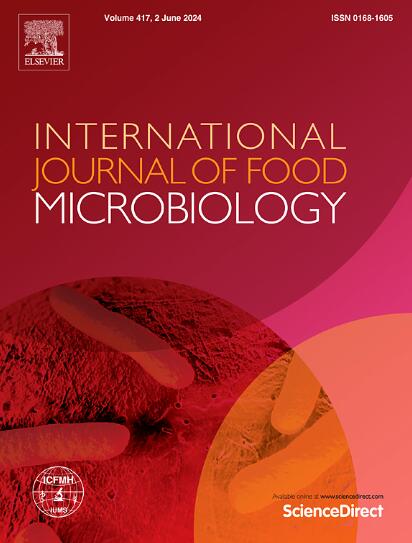Ultrahigh pressure treatment of Actinidia arguta turbid juice: Kinetics of microbial inactivation and assessment of bioactive ingredient availability
IF 5
1区 农林科学
Q1 FOOD SCIENCE & TECHNOLOGY
International journal of food microbiology
Pub Date : 2025-06-09
DOI:10.1016/j.ijfoodmicro.2025.111316
引用次数: 0
Abstract
Mathematical models can be used to predict the kinetics of microbial inactivation in Actinidia arguta juice (AAJ) during ultra-high pressure (UHP) treatment. The inactivation of E. coli, S. aureus and S. cerevisiae by UHP was investigated. The pressure levels ranged from 100 to 500 MPa and the treatment time was 0–10 min. Cell morphology, intracellular protein content and cell membrane structure of UHP-treated microorganisms were evaluated. In addition, the effect of UHP treatment on the bioacceptability of AAJ was explored by an in vitro simulated gastrointestinal test. The maximum reduction of E. coli (5.14 lg), S. aureus (3.12 lg) and S. cerevisiae (3.94 lg) was achieved at 500 MPa/10 min. The coefficient of determination (0.957–0.999), root mean square error (0.010–0.343), coefficient of precision (1.033–1.213), and coefficient of deviation (0.876–1.068) indicated the satisfactory performance of the Weibull and Log-logistic model. The correlation coefficients of the predicted values of the Weibull model with the measured values (0.9938–0.9967) was higher than that of the Log-logistic model (0.9795–0.9909) and was considered to be the appropriate model. The UHP treatment increased (p < 0.05) the content of total phenols, total flavonoids, total sugars, and ascorbic acid in the juice. At the end of the simulated digestion, UHP-treated AAJ retained a higher content of bioactive compounds and antioxidant capacity (p < 0.05). The potential application of UHP in improving the nutritional value and health functions of different foods can be further explored in the future.
超高压处理软枣猕猴桃混浊汁:微生物失活动力学和生物活性成分有效性评估
数学模型可以用来预测在超高压(UHP)处理过程中软枣猕猴桃汁(AAJ)微生物失活动力学。研究了超高压对大肠杆菌、金黄色葡萄球菌和酿酒葡萄球菌的灭活作用。压力水平为100 ~ 500 MPa,处理时间为0 ~ 10 min。对uhp处理微生物的细胞形态、细胞内蛋白含量和细胞膜结构进行了评价。此外,通过体外模拟胃肠试验,探讨超高压处理对AAJ生物接受性的影响。在500 MPa/10 min下,大肠杆菌(5.14 lg)、金黄色葡萄球菌(3.12 lg)和酿酒葡萄球菌(3.94 lg)的最大减菌量达到了500 MPa/10 min。测定系数(0.957 ~ 0.999)、均方根误差(0.010 ~ 0.343)、精密度系数(1.033 ~ 1.213)和偏差系数(0.876 ~ 1.068)表明,Weibull和Log-logistic模型具有良好的效果。Weibull模型预测值与实测值的相关系数(0.9938 ~ 0.9967)高于Log-logistic模型的相关系数(0.9795 ~ 0.9909),认为Weibull模型是合适的模型。超高压处理增加(p <;0.05)果汁中总酚、总黄酮、总糖和抗坏血酸的含量。在模拟消化结束时,uhp处理的AAJ保留了较高的生物活性化合物含量和抗氧化能力(p <;0.05)。超高压在提高不同食品的营养价值和保健功能方面的潜在应用前景有待进一步探索。
本文章由计算机程序翻译,如有差异,请以英文原文为准。
求助全文
约1分钟内获得全文
求助全文
来源期刊
CiteScore
10.40
自引率
5.60%
发文量
322
审稿时长
65 days
期刊介绍:
The International Journal of Food Microbiology publishes papers dealing with all aspects of food microbiology. Articles must present information that is novel, has high impact and interest, and is of high scientific quality. They should provide scientific or technological advancement in the specific field of interest of the journal and enhance its strong international reputation. Preliminary or confirmatory results as well as contributions not strictly related to food microbiology will not be considered for publication.

 求助内容:
求助内容: 应助结果提醒方式:
应助结果提醒方式:


